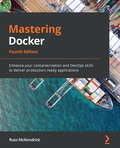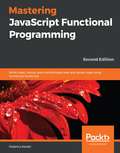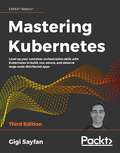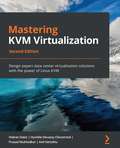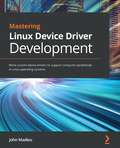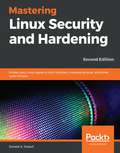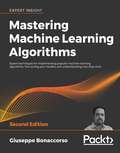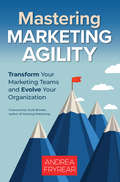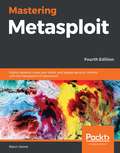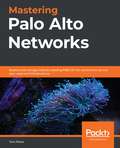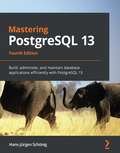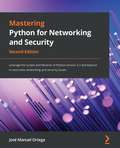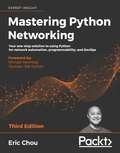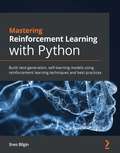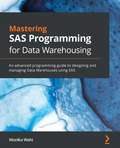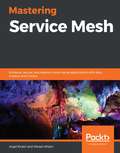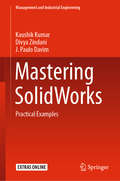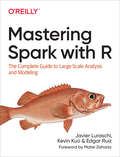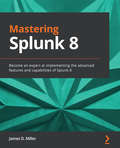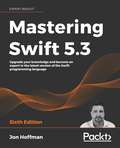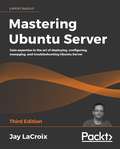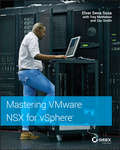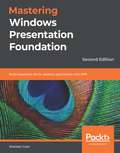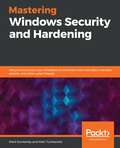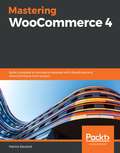- Table View
- List View
Mastering Docker: Enhance your containerization and DevOps skills to deliver production-ready applications, 4th Edition
by Russ McKendrickUnlock the full potential of the Docker containerization platform with this practical guideKey FeaturesExplore tools such as Docker Engine, Machine, Compose, and SwarmDiscover how you can integrate Docker into your everyday workflowsGet well-versed with Kubernetes options such as Minikube, Kind, and MicroK8sBook DescriptionDocker has been a game changer when it comes to how modern applications are deployed and created. It has now grown into a key driver of innovation beyond system administration, with a significant impact on the world of web development. Mastering Docker shows you how you can ensure that you're keeping up with the innovations it's driving and be sure you're using it to its full potential. This fourth edition not only demonstrates how to use Docker more effectively but also helps you rethink and reimagine what you can achieve with it.You'll start by building, managing, and storing images along with exploring best practices for working with Docker confidently. Once you've got to grips with Docker security, the book covers essential concepts for extending and integrating Docker in new and innovative ways. You'll also learn how to take control of your containers efficiently using Docker Compose, Docker Swarm, and Kubernetes.By the end of this Docker book, you'll have a broad yet detailed sense of what's possible with Docker and how seamlessly it fits in with a range of other platforms and tools.What you will learnGet to grips with essential Docker components and conceptsDiscover the best ways to build, store, and distribute container imagesUnderstand how Docker can fit into your development workflowSecure your containers and files with Docker's security featuresExplore first-party and third-party cluster tools and pluginsLaunch and manage your Kubernetes clusters in major public cloudsWho this book is forIf you are a software architect, DevOps engineer, sysadmin, or IT professional looking to leverage Docker's extensive features for innovating any process from system administration to web development, Mastering Docker will show you how you can use it to its full potential. A basic understanding of containerization and prior Docker experience is necessary.
Mastering JavaScript Functional Programming: Write clean, robust, and maintainable web and server code using functional JavaScript, 2nd Edition
by Federico KerekiExplore the functional programming paradigm and the different techniques for developing better algorithms, writing more concise code, and performing seamless testing Key Features Explore this second edition updated to cover features like async functions and transducers, as well as functional reactive programming Enhance your functional programming (FP) skills to build web and server apps using JavaScript Use FP to enhance the modularity, reusability, and performance of apps Book Description Functional programming is a paradigm for developing software with better performance. It helps you write concise and testable code. To help you take your programming skills to the next level, this comprehensive book will assist you in harnessing the capabilities of functional programming with JavaScript and writing highly maintainable and testable web and server apps using functional JavaScript. This second edition is updated and improved to cover features such as transducers, lenses, prisms and various other concepts to help you write efficient programs. By focusing on functional programming, you'll not only start to write but also to test pure functions, and reduce side effects. The book also specifically allows you to discover techniques for simplifying code and applying recursion for loopless coding. Gradually, you'll understand how to achieve immutability, implement design patterns, and work with data types for your application, before going on to learn functional reactive programming to handle complex events in your app. Finally, the book will take you through the design patterns that are relevant to functional programming. By the end of this book, you'll have developed your JavaScript skills and have gained knowledge of the essential functional programming techniques to program effectively. What you will learn Simplify JavaScript coding using function composition, pipelining, chaining, and transducing Use declarative coding as opposed to imperative coding to write clean JavaScript code Create more reliable code with closures and immutable data Apply practical solutions to complex programming problems using recursion Improve your functional code using data types, type checking, and immutability Understand advanced functional programming concepts such as lenses and prisms for data access Who this book is for This book is for JavaScript developers who want to enhance their programming skills and build efficient web applications. Frontend and backend developers who use various JavaScript frameworks and libraries like React, Angular, or Node.js will also find the book helpful. Working knowledge of ES2019 is required to grasp the concepts covered in the book easily.
Mastering Kubernetes: Level up your container orchestration skills with Kubernetes to build, run, secure, and observe large-scale distributed apps, 3rd Edition
by Gigi SayfanGo beyond simply learning Kubernetes fundamentals and its deployment, and explore more advanced concepts, including serverless computing and service meshes with the latest updates Key Features Master Kubernetes architecture and design to build and deploy secure distributed applications Learn advanced concepts like autoscaling, cluster federation, serverless computing, and service mesh integration for observability Explore Kubernetes 1.18 features and its rich ecosystem of tools like Kubectl, Knative, and Helm Book Description The third edition of Mastering Kubernetes is updated with the latest tools and code enabling you to learn Kubernetes 1.18's latest features. This book primarily concentrates on diving deeply into complex concepts and Kubernetes best practices to help you master the skills of designing and deploying large clusters on various cloud platforms. The book trains you to run complex stateful microservices on Kubernetes including advanced features such as horizontal pod autoscaling, rolling updates, resource quotas, and persistent storage backend. With the two new chapters, you will gain expertise in serverless computing and utilizing service meshes. As you proceed through the chapters, you will explore different options for network configuration and learn to set up, operate, and troubleshoot Kubernetes networking plugins through real-world use cases. Furthermore, you will understand the mechanisms of custom resource development and its utilization in automation and maintenance workflows. By the end of this Kubernetes book, you will graduate from an intermediate to advanced Kubernetes professional. What you will learn Master the fundamentals of Kubernetes architecture and design Build and run stateful applications and complex microservices on Kubernetes Use tools like Kubectl, secrets, and Helm to manage resources and storage Master Kubernetes Networking with load balancing options like Ingress Achieve high-availability Kubernetes clusters Improve Kubernetes observability with tools like Prometheus, Grafana, and Jaeger Extend Kubernetes working with Kubernetes API, plugins, and webhooks Who this book is for If you are a system administrator or a cloud developer with working knowledge of Kubernetes and are keen to master its advanced features, along with learning everything from building microservices to utilizing service meshes, Mastering Kubernetes is for you. Basic familiarity with networking concepts will be helpful.
Mastering KVM Virtualization: Design expert data center virtualization solutions with the power of Linux KVM, 2nd Edition
by Vedran Dakic Humble Devassy Chirammal Prasad Mukhedkar Anil VettathuIf you are a systems administrator, DevOps practitioner, or developer with Linux experience looking to sharpen your open-source virtualization skills, this virtualization book is for you. Prior understanding of the Linux command line and virtualization is required before getting started with this book.
Mastering Linux Device Drivers Development: Write Custom Device Drivers To Support Computer Peripherals In Linux Operating Systems
by John MadieuThis book is for embedded developers, Linux system engineers, and system programmers who want to explore Linux kernel frameworks and subsystems. C programming skills and a basic understanding of driver development is necessary to get started with this book.
Mastering Linux Security and Hardening - Second Edition: Protect your Linux systems from intruders, malware attacks, and other cyber threats, 2nd Edition
by Donald TevaultThis book is for Linux administrators, or aspiring Linux administrators. Readers should know the basics of Linux command-line usage and package management and should be familiar with the process of installing a Linux operating system, either on bare metal or in a virtual machine.
Mastering Machine Learning Algorithms: Expert techniques for implementing popular machine learning algorithms, fine-tuning your models, and understanding how they work, 2nd Edition
by Giuseppe BonaccorsoUpdated and revised second edition of the bestselling guide to exploring and mastering the most important algorithms for solving complex machine learning problems Key Features Updated to include new algorithms and techniques Code updated to Python 3.8 & TensorFlow 2.x New coverage of regression analysis, time series analysis, deep learning models, and cutting-edge applications Book Description Mastering Machine Learning Algorithms, Second Edition helps you harness the real power of machine learning algorithms in order to implement smarter ways of meeting today's overwhelming data needs. This newly updated and revised guide will help you master algorithms used widely in semi-supervised learning, reinforcement learning, supervised learning, and unsupervised learning domains. You will use all the modern libraries from the Python ecosystem – including NumPy and Keras – to extract features from varied complexities of data. Ranging from Bayesian models to the Markov chain Monte Carlo algorithm to Hidden Markov models, this machine learning book teaches you how to extract features from your dataset, perform complex dimensionality reduction, and train supervised and semi-supervised models by making use of Python-based libraries such as scikit-learn. You will also discover practical applications for complex techniques such as maximum likelihood estimation, Hebbian learning, and ensemble learning, and how to use TensorFlow 2.x to train effective deep neural networks. By the end of this book, you will be ready to implement and solve end-to-end machine learning problems and use case scenarios. What you will learn Understand the characteristics of a machine learning algorithm Implement algorithms from supervised, semi-supervised, unsupervised, and RL domains Learn how regression works in time-series analysis and risk prediction Create, model, and train complex probabilistic models Cluster high-dimensional data and evaluate model accuracy Discover how artificial neural networks work – train, optimize, and validate them Work with autoencoders, Hebbian networks, and GANs Who this book is for This book is for data science professionals who want to delve into complex ML algorithms to understand how various machine learning models can be built. Knowledge of Python programming is required.
Mastering Marketing Agility: Transform Your Marketing Teams and Evolve Your Organization
by Andrea FryrearThe leading authority on agile marketing shows how to build marketing operations that can pivot freely and yet remain committed to priorities.As a marketer, are you tired of chasing marketing fads and algorithm rumors that seem to change every couple of months? This guide to building the perfect marketing department will help you achieve the latest and greatest without having to rebuild your operations from scratch every time the wind shifts. Agile strategies have been the accepted modus operandi for software development for two decades, and marketing is poised to follow in its footsteps. As the audiences we market to become ever more digital, agile frameworks are emerging as the best and only way to manage marketing. This book is a signpost showing the way toward the agile future of marketing operations, explaining how every role, from social media intern up to chief marketing officer, can work in unison, responding to the market's demanding challenges without losing focus on the big picture.You will learn what it takes for marketing agility to thrive—customer focus, transparency, continuous improvement, adaptability, trust, bias for action, and courage—along with the antipatterns that can drag you down. Most important, you will learn how to implement the systems, strategies, and practices that will truly transform your marketing operations.
Mastering Metasploit - Fourth Edition
by Nipun JaswalThis book targets professional penetration testers, security engineers, and law enforcement analysts who possess a basic knowledge of Metasploit, wish to master the Metasploit framework, and want to develop exploit and module development skills. Further, it helps all those researchers who want to add their custom functionalities to Metasploit. The book discusses Ruby programming and attack scripting using Cortana. A little knowledge and programming experience with Ruby and Cortana are required.
Mastering Palo Alto Networks: Deploy and manage industry-leading PAN-OS 10.x solutions to secure your users and infrastructure
by Tom PiensSet up next-generation firewalls from Palo Alto Networks and get to grips with configuring and troubleshooting using the PAN-OS platformKey FeaturesUnderstand how to optimally use PAN-OS featuresBuild firewall solutions to safeguard local, cloud, and mobile networksProtect your infrastructure and users by implementing robust threat prevention solutionsBook DescriptionTo safeguard against security threats, it is crucial to ensure that your organization is effectively secured across networks, mobile devices, and the cloud. Palo Alto Networks' integrated platform makes it easy to manage network and cloud security along with endpoint protection and a wide range of security services. With this book, you'll understand Palo Alto Networks and learn how to implement essential techniques, right from deploying firewalls through to advanced troubleshooting.The book starts by showing you how to set up and configure the Palo Alto Networks firewall, helping you to understand the technology and appreciate the simple, yet powerful, PAN-OS platform. Once you've explored the web interface and command-line structure, you'll be able to predict expected behavior and troubleshoot anomalies with confidence. You'll learn why and how to create strong security policies and discover how the firewall protects against encrypted threats. In addition to this, you'll get to grips with identifying users and controlling access to your network with user IDs and even prioritize traffic using quality of service (QoS). The book will show you how to enable special modes on the firewall for shared environments and extend security capabilities to smaller locations.By the end of this network security book, you'll be well-versed with advanced troubleshooting techniques and best practices recommended by an experienced security engineer and Palo Alto Networks expert.What you will learnPerform administrative tasks using the web interface and command-line interface (CLI)Explore the core technologies that will help you boost your network securityDiscover best practices and considerations for configuring security policiesRun and interpret troubleshooting and debugging commandsManage firewalls through Panorama to reduce administrative workloadsProtect your network from malicious traffic via threat preventionWho this book is forThis book is for network engineers, network security analysts, and security professionals who want to understand and deploy Palo Alto Networks in their infrastructure. Anyone looking for in-depth knowledge of Palo Alto Network technologies, including those who currently use Palo Alto Network products, will find this book useful. Intermediate-level network administration knowledge is necessary to get started with this cybersecurity book.
Mastering PostgreSQL 13: Build, administer, and maintain database applications efficiently with PostgreSQL 13, 4th Edition
by Hans-Jurgen SchonigExplore expert techniques such as advanced indexing and high availability to build scalable, reliable, and fault-tolerant database applications using PostgreSQL 13Key FeaturesMaster advanced PostgreSQL 13 concepts with the help of real-world datasets and examplesLeverage PostgreSQL's indexing features to fine-tune the performance of your queriesExtend PostgreSQL's functionalities to suit your organization's needs with minimal effortBook DescriptionThanks to its reliability, robustness, and high performance, PostgreSQL has become one of the most advanced open source databases on the market. This updated fourth edition will help you understand PostgreSQL administration and how to build dynamic database solutions for enterprise apps with the latest release of PostgreSQL, including designing both physical and technical aspects of the system architecture with ease.Starting with an introduction to the new features in PostgreSQL 13, this book will guide you in building efficient and fault-tolerant PostgreSQL apps. You'll explore advanced PostgreSQL features, such as logical replication, database clusters, performance tuning, advanced indexing, monitoring, and user management, to manage and maintain your database. You'll then work with the PostgreSQL optimizer, configure PostgreSQL for high speed, and move from Oracle to PostgreSQL. The book also covers transactions, locking, and indexes, and shows you how to improve performance with query optimization. You'll also focus on how to manage network security and work with backups and replication while exploring useful PostgreSQL extensions that optimize the performance of large databases.By the end of this PostgreSQL book, you'll be able to get the most out of your database by executing advanced administrative tasks.What you will learnGet well versed with advanced SQL functions in PostgreSQL 13Get to grips with administrative tasks such as log file management and monitoringWork with stored procedures and manage backup and recoveryEmploy replication and failover techniques to reduce data lossPerform database migration from Oracle to PostgreSQL with easeReplicate PostgreSQL database systems to create backups and scale your databaseManage and improve server security to protect your dataTroubleshoot your PostgreSQL instance to find solutions to common and not-so-common problemsWho this book is forThis database administration book is for PostgreSQL developers and database administrators and professionals who want to implement advanced functionalities and master complex administrative tasks with PostgreSQL 13. Prior experience in PostgreSQL and familiarity with the basics of database administration will assist with understanding key concepts covered in the book.
Mastering Python for Networking and Security - Second Edition
by José Manuel OrtegaThis Python network security book is for network engineers, system administrators, or any security professional looking to overcome networking and security challenges. You will also find this book useful if you’re a programmer with prior experience in Python. A basic understanding of general programming structures and the Python programming language is required before getting started.
Mastering Python Networking: Your one-stop solution to using Python for network automation, programmability, and DevOps, 3rd Edition
by Eric Chou Michael Kennedy Mandy WhaleyNew edition of the bestselling guide to mastering Python Networking, updated to Python 3 and including the latest on network data analysis, Cloud Networking, Ansible 2.8, and new libraries Key Features Explore the power of Python libraries to tackle difficult network problems efficiently and effectively, including pyATS, Nornir, and Ansible 2.8 Use Python and Ansible for DevOps, network device automation, DevOps, and software-defined networking Become an expert in implementing advanced network-related tasks with Python 3 Book Description Networks in your infrastructure set the foundation for how your application can be deployed, maintained, and serviced. Python is the ideal language for network engineers to explore tools that were previously available to systems engineers and application developers. In Mastering Python Networking, Third edition, you'll embark on a Python-based journey to transition from traditional network engineers to network developers ready for the next-generation of networks. This new edition is completely revised and updated to work with Python 3. In addition to new chapters on network data analysis with ELK stack (Elasticsearch, Logstash, Kibana, and Beats) and Azure Cloud Networking, it includes updates on using newer libraries such as pyATS and Nornir, as well as Ansible 2.8. Each chapter is updated with the latest libraries with working examples to ensure compatibility and understanding of the concepts. Starting with a basic overview of Python, the book teaches you how it can interact with both legacy and API-enabled network devices. You will learn to leverage high-level Python packages and frameworks to perform network automation tasks, monitoring, management, and enhanced network security followed by Azure and AWS Cloud networking. Finally, you will use Jenkins for continuous integration as well as testing tools to verify your network. What you will learn Use Python libraries to interact with your network Integrate Ansible 2.8 using Python to control Cisco, Juniper, and Arista network devices Leverage existing Flask web frameworks to construct high-level APIs Learn how to build virtual networks in the AWS & Azure Cloud Learn how to use Elastic Stack for network data analysis Understand how Jenkins can be used to automatically deploy changes in your network Use PyTest and Unittest for Test-Driven Network Development in networking engineering with Python Who this book is for Mastering Python Networking, Third edition is for network engineers, developers, and SREs who want to use Python for network automation, programmability, and data analysis. Basic familiarity with Python programming and networking-related concepts such as Transmission Control Protocol/Internet Protocol (TCP/IP) will be useful.
Mastering Reinforcement Learning with Python: Build next-generation, self-learning models using reinforcement learning techniques and best practices
by Enes BilginThis book is for expert machine learning practitioners and deep learning researchers looking to implement advanced RL concepts in real-world projects. This book will also appeal to RL experts who want to tackle complex sequential decision-making problems through self-learning agents. Working knowledge of Python programming and machine learning along with prior experience with reinforcement learning is required.
Mastering SAS Programming
by Monika WahiThis book is for managers leading data projects, and programmers or developers using SAS who want to effectively maintain a data lake, data mart, or data warehouse.
Mastering Service Mesh: Enhance, secure, and observe cloud-native applications with Istio, Linkerd, and Consul
by Anjali Khatri Vikram Khatri Dinesh Nirmal Hamid Pirahesh Eric HernessUnderstand how to use service mesh architecture to efficiently manage and safeguard microservices-based applications with the help of examples Key Features Manage your cloud-native applications easily using service mesh architecture Learn about Istio, Linkerd, and Consul – the three primary open source service mesh providers Explore tips, techniques, and best practices for building secure, high-performance microservices Book Description Although microservices-based applications support DevOps and continuous delivery, they can also add to the complexity of testing and observability. The implementation of a service mesh architecture, however, allows you to secure, manage, and scale your microservices more efficiently. With the help of practical examples, this book demonstrates how to install, configure, and deploy an efficient service mesh for microservices in a Kubernetes environment. You'll get started with a hands-on introduction to the concepts of cloud-native application management and service mesh architecture, before learning how to build your own Kubernetes environment. While exploring later chapters, you'll get to grips with the three major service mesh providers: Istio, Linkerd, and Consul. You'll be able to identify their specific functionalities, from traffic management, security, and certificate authority through to sidecar injections and observability. By the end of this book, you will have developed the skills you need to effectively manage modern microservices-based applications. What you will learn Compare the functionalities of Istio, Linkerd, and Consul Become well-versed with service mesh control and data plane concepts Understand service mesh architecture with the help of hands-on examples Work through hands-on exercises in traffic management, security, policy, and observability Set up secure communication for microservices using a service mesh Explore service mesh features such as traffic management, service discovery, and resiliency Who this book is for This book is for solution architects and network administrators, as well as DevOps and site reliability engineers who are new to the cloud-native framework. You will also find this book useful if you're looking to build a career in DevOps, particularly in operations. Working knowledge of Kubernetes and building microservices that are cloud-native is necessary to get the most out of this book.
Mastering SolidWorks: Practical Examples (Management and Industrial Engineering)
by J. Paulo Davim Kaushik Kumar Divya ZindaniThis book provides the reader with a comprehensive knowledge of all the tools provided in the software SOLIDWORKS for a variety of engineering areas. It presents a broad choice of examples to be imitated in one’s own work. In developing these examples, the authors’ intent has been to exercise many program features and refinements. By displaying these, the authors hope to give readers the confidence to employ these program enhancements in their own modeling applications.
Mastering Spark with R: The Complete Guide to Large-Scale Analysis and Modeling
by Javier Luraschi Kevin Kuo Edgar RuizIf you’re like most R users, you have deep knowledge and love for statistics. But as your organization continues to collect huge amounts of data, adding tools such as Apache Spark makes a lot of sense. With this practical book, data scientists and professionals working with large-scale data applications will learn how to use Spark from R to tackle big data and big compute problems.Authors Javier Luraschi, Kevin Kuo, and Edgar Ruiz show you how to use R with Spark to solve different data analysis problems. This book covers relevant data science topics, cluster computing, and issues that should interest even the most advanced users.Analyze, explore, transform, and visualize data in Apache Spark with RCreate statistical models to extract information and predict outcomes; automate the process in production-ready workflowsPerform analysis and modeling across many machines using distributed computing techniquesUse large-scale data from multiple sources and different formats with ease from within SparkLearn about alternative modeling frameworks for graph processing, geospatial analysis, and genomics at scaleDive into advanced topics including custom transformations, real-time data processing, and creating custom Spark extensions
Mastering Splunk 8: Become an expert at implementing the advanced features and capabilities of Splunk 8
by James D. MillerDelve into Splunk and extend intelligence capabilities, and leverage machine learning to explore data efficientlyKey FeaturesGain the expertise you need to implement the advanced features and capabilities of Splunk 8Get to grips with advanced Splunk features and create compelling reports and dashboardsDevelop and manage advanced Splunk pipelines to integrate intelligence capabilities within your organizationBook DescriptionSplunk is the most widely used engine for working with machine-generated data. This expert-level guide will help you to leverage advanced use cases to drive business growth using operational intelligence and business analytics features. You'll start with an introduction to the new features in Splunk 8 and cover step-by-step exercises that will help you to understand each feature in depth. Next, you'll explore key tasks such as workload management, performance and alerting, Splunk Enterprise Security, and advanced indexing. You'll also learn how to create categorical charts and run analytical operations on metrics within the Splunk Analytics workspace, before understanding how to deliver insights across your organization even when faced with limited or complex data using advanced data analytics. The book will also show you how to monitor and maintain Splunk environments using advanced dashboards. Later, you'll create custom data visualizations and update dashboards using drag and drop and the UI-based dashboard editor. Finally, you'll add SplunkJS to a web app and use the Splunk Machine Learning Toolkit (MLTK) as an extension to the core Splunk platform using real-world use cases. By the end of this book, you'll have learned how to use various Splunk features to extend intelligence capabilities and perform machine learning to explore data effectively.What you will learnUnderstand the components of Splunk 8 and how they workConvert distributed search environments to clusters and configure disaster recovery sites using index clusteringFind out how to integrate Splunk with platforms such as AWS and Microsoft AzureUse Search Processing Language (SPL) within Splunk macros to create efficient searchingDetect suspicious patterns in data with advanced event correlation searchesExplore machine learning with Splunk MLTKReview the beta dashboard editor using working examplesUse SplunkJS Stack libraries to enhance web appsWho this book is forThis Splunk book is for data professionals, data analysts, and Splunk users looking to leverage the advanced features of the Splunk Enterprise platform to derive valuable business insights from machine data. The book is also a useful expert-level guide for individuals from all facets of IT, business, and security. Prior knowledge of Splunk and its features is mandatory to get the most out of this book.
Mastering Swift 5.3: Upgrade your knowledge and become an expert in the latest version of the Swift programming language, 6th Edition
by Jon HoffmanA comprehensive guide for programming enthusiasts who wish to gain a firm command of the fundamentals and advanced Swift conceptsKey FeaturesSixth edition of this bestselling book, improved and updated to cover the latest version of the Swift 5.3 programming languageGet to grips with popular and modern design techniques to write easy-to-manage Swift codeUse core Swift features such as concurrency, generics, and copy-on-write in your codeBook DescriptionOver the years, Mastering Swift has proven itself among developers as a popular choice for an in-depth and practical guide to the Swift programming language. This sixth edition comes with the latest features, an overall revision to align with Swift 5.3, and two new chapters on building swift from source and advanced operators.From the basics of the language to popular features such as concurrency, generics, and memory management, this in-depth guide will help you develop your expertise and mastery of the language.As you progress, you will gain practical insights into some of the most sophisticated elements in Swift development, including protocol extensions, error handling, and closures. The book will also show you how to use and apply them in your own projects. In later chapters, you will understand how to use the power of protocol-oriented programming to write flexible and easier-to-manage code in Swift. Finally, you will learn how to add the copy-on-write feature to your custom value types, along with understanding how to avoid memory management issues caused by strong reference cycles.By the end of this Swift book, you will have mastered the Swift 5.3 language and developed the skills you need to effectively use its features to build robust applications.What you will learnUnderstand core Swift components, such as operators, collections, control flows, and functionsIdentify how and when to use classes, structures, and enumerationsUse protocol-oriented design with extensions to write easy-to-manage codeLeverage design patterns with Swift to solve commonly occurring design problemsApply copy-on-write for your custom value types to improve performanceAdd concurrency to your applications using Grand Central Dispatch and operation queuesImplement generics to write flexible and reusable codeWho this book is forThis book is for beginners with a basic understanding of programming and experienced developers looking to learn Swift programming. Familiarity with Apple's tools will be beneficial but not mandatory. All examples should also work on the Linux and Windows platforms
Mastering Ubuntu Server: Gain expertise in the art of deploying, configuring, managing, and troubleshooting Ubuntu Server, 3rd Edition
by Jay LaCroixThis is the third edition of the bestselling one-stop resource for sysadmins and DevOps professionals to learn, configure and use Ubuntu 20.04 for their day-to-day operations and deployments.Key FeaturesA hands-on book that will teach you how to deploy, maintain and troubleshoot Ubuntu ServerLearn to leverage the improved performance and security-related aspects of Ubuntu Server 20.04 LTSNew chapters dedicated to exploring Ubuntu for cloudBook DescriptionUbuntu Server has taken data centers around the world by storm. Whether you're deploying Ubuntu for a large-scale project or for a small office, it is a stable, customizable, and powerful Linux distribution with innovative and cutting-edge features. For both simple and complex server deployments, Ubuntu's flexible nature can be easily adapted to meet to the needs of your organization. This third edition is updated to cover the advancements of Ubuntu 20.04 LTS and further train you to understand how to use Ubuntu Server, from initial deployment to creating production-ready resources for your network. The book begins with the concepts of user management, group management, and file system permissions. Continuing into managing storage volumes, you will learn how to format storage devices, utilize logical volume management, and monitor disk usage. Later, you will learn how to virtualize hosts and applications, which will include setting up QEMU & KVM, as well as containerization with both Docker and LXD. As the book continues, you will learn how to automate configuration with Ansible, as well as take a look at writing scripts. Lastly, you will explore best practices and troubleshooting techniques when working with Ubuntu Server that are applicable to real-world scenarios. By the end of this Ubuntu Server book, you will be well-versed in Ubuntu server's advanced concepts and attain the required proficiency needed for Ubuntu Server administration.What you will learnManage users, groups, and permissionsOptimize the performance of system resourcesPerform disk encryption and decryption with Linux Unified Key Setup (LUKS)Set up Secure Shell (SSH) for remote access, and connect it to other nodesShare directories using Samba and Network File System (NFS)Get familiar with scripting to improve command-line efficiencyConfigure VMs, containers, and orchestrate with MicroK8s and KubernetesAutomate server deployments with Ansible and cloud server deployments with TerraformWho this book is forThe book is written to cater to sysadmins and DevOps professionals whose teams are planning to employ an Ubuntu/Linux environment for their development needs.Prior knowledge of Ubuntu is not required. However, it is assumed that you possess some IT admin, Linux, and shell scripting experience.
Mastering VMware NSX for vSphere
by Elver Sena SosaA clear, comprehensive guide to VMware’s latest virtualization solution Mastering VMware NSX for vSphere is the ultimate guide to VMware’s network security virtualization platform. Written by a rock star in the VMware community, this book offers invaluable guidance and crucial reference for every facet of NSX, with clear explanations that go far beyond the public documentation. Coverage includes NSX architecture, controllers, and edges; preparation and deployment; logical switches; VLANS and VXLANS; logical routers; virtualization; edge network services; firewall security; and much more to help you take full advantage of the platform’s many features. More and more organizations are recognizing both the need for stronger network security and the powerful solution that is NSX; usage has doubled in the past year alone, and that trend is projected to grow—and these organizations need qualified professionals who know how to work effectively with the NSX platform. This book covers everything you need to know to exploit the platform’s full functionality so you can: Step up security at the application level Automate security and networking services Streamline infrastructure for better continuity Improve compliance by isolating systems that handle sensitive data VMware’s NSX provides advanced security tools at a lower cost than traditional networking. As server virtualization has already become a de facto standard in many circles, network virtualization will follow quickly—and NSX positions VMware in the lead the way vSphere won the servers. NSX allows you to boost security at a granular level, streamline compliance, and build a more robust defense against the sort of problems that make headlines. Mastering VMware NSX for vSphere helps you get up to speed quickly and put this powerful platform to work for your organization.
Mastering Windows Presentation Foundation: Build responsive UIs for desktop applications with WPF, 2nd Edition
by Sheridan YuenGain the expertise you need to build custom application frameworks and responsive and visually appealing user interfaces with WPF, C#, and .NET Key Features Discover a smarter way of working with WPF using the MVVM software architectural pattern Create your own lightweight application framework to build your future applications upon Understand data binding and learn how to use it in an application Book Description Microsoft Windows Presentation Foundation (WPF) provides several libraries and APIs for developers to create engaging user experiences. This book features a wide range of simple through to complex examples to demonstrate how to develop enterprise-grade applications for Windows desktop with WPF. This updated second edition of Mastering Windows Presentation Foundation starts by covering the benefits of using the Model-View-ViewModel (MVVM) software architectural pattern with WPF, before guiding you through debugging your WPF apps. The book will then take you through the application architecture and building the foundation layer for your apps. As you advance, you'll get to grips with data binding, explore the various built-in WPF controls, and customize them to suit your requirements. You'll learn how to create custom controls to meet your needs when the built-in functionality is not enough. You'll also learn how to enhance your applications using practical animations, stunning visuals, and responsive data validation. To ensure that your app is not only interactive but also efficient, you'll focus on improving application performance, and finally, discover the different methods for deploying your applications. By the end of this book, you'll be proficient in using WPF for developing efficient yet robust user interfaces. What you will learn Discover MVVM and how it assists development with WPF Implement your own custom application framework Become proficient with Data Binding Understand how to adapt the built-in controls Get up to speed with animations Implement responsive data validation Create visually appealing user interfaces Improve application performance Learn how to deploy your applications Who this book is for This Windows book is for developers with basic to intermediate-level knowledge of Windows Presentation Foundation and for those interested in simply enhancing their WPF skills. If you're looking to learn more about application architecture and designing user interfaces in a visually appealing manner, you'll find this book useful.
Mastering Windows Security and Hardening: Secure and protect your Windows environment from intruders, malware attacks, and other cyber threats
by Mark Dunkerley Matt TumbarelloEnhance Windows security and protect your systems and servers from various cyber attacks Key Features Protect your device using a zero-trust approach and advanced security techniques Implement efficient security measures using Microsoft Intune, Configuration Manager, and Azure solutions Understand how to create cyber-threat defense solutions effectively Book Description Are you looking for effective ways to protect Windows-based systems from being compromised by unauthorized users? Mastering Windows Security and Hardening is a detailed guide that helps you gain expertise when implementing efficient security measures and creating robust defense solutions. We will begin with an introduction to Windows security fundamentals, baselining, and the importance of building a baseline for an organization. As you advance, you will learn how to effectively secure and harden your Windows-based system, protect identities, and even manage access. In the concluding chapters, the book will take you through testing, monitoring, and security operations. In addition to this, you'll be equipped with the tools you need to ensure compliance and continuous monitoring through security operations. By the end of this book, you'll have developed a full understanding of the processes and tools involved in securing and hardening your Windows environment. What you will learn Understand baselining and learn the best practices for building a baseline Get to grips with identity management and access management on Windows-based systems Delve into the device administration and remote management of Windows-based systems Explore security tips to harden your Windows server and keep clients secure Audit, assess, and test to ensure controls are successfully applied and enforced Monitor and report activities to stay on top of vulnerabilities Who this book is for This book is for system administrators, cybersecurity and technology professionals, solutions architects, or anyone interested in learning how to secure their Windows-based systems. A basic understanding of Windows security concepts, Intune, Configuration Manager, Windows PowerShell, and Microsoft Azure will help you get the best out of this book.
Mastering WooCommerce 4: Build complete e-commerce websites with WordPress and WooCommerce from scratch
by Patrick RaulandUnderstand all aspects of building a successful online store which is search-engine-optimized, using theme management and one-page checkout features Key Features Extend your WordPress knowledge to build fully functional e-commerce websites using WooCommerce and its plugins Implement payment gateway, shipping, and inventory management solutions Improve the speed and performance of your websites by optimizing images and caching static information Book Description WooCommerce is one of the most flexible platforms for building online stores. With its flexibility, you can offer virtually any feature to a client using the WordPress system. WooCommerce is also self-hosted, so the ownership of data lies with you and your client. This book starts with the essentials of building a WooCommerce store. You'll learn how to set up WooCommerce and implement payment, shipping, and tax options, as well as configure your product. The book also demonstrates ways to customize and manage your products by using SEO for enhanced visibility. As you advance, you'll understand how to manage sales by using POS systems, outsource fulfillment, and external reporting services. Once you've set up and organized your online store, you'll focus on improving the user experience of your e-commerce website. In addition to this, the book takes you through caching techniques to not only improve the speed and performance of your website but also its look and UI by adding themes. Finally, you'll build the landing page for your website to promote your product, and design WooCommerce plugins to customize the functionalities of your e-commerce website. By the end of this WooCommerce book, you'll have learned how to run a complete WooCommerce store, and be able to customize each section of the store on the frontend as well as backend. What you will learn Grasp the fundamentals of e-commerce website design and management with WordPress Use Gutenberg product blocks to display products across various categories on your website Get to grips with WordPress plugin development to customize your website's functionality Discover various ways to effectively handle product payment, taxes, and shipping Use analytics and product data syncing in WordPress to keep an eye on the user experience and monitor the performance of your online store Promote your new product online using SEO management and landing pages Who this book is for This WooCommerce development book is for web developers, WordPress developers, e-commerce consultants, or anyone familiar with using WordPress and interested in building an e-commerce platform from scratch. Working knowledge of WordPress development and general web development concepts is required.
